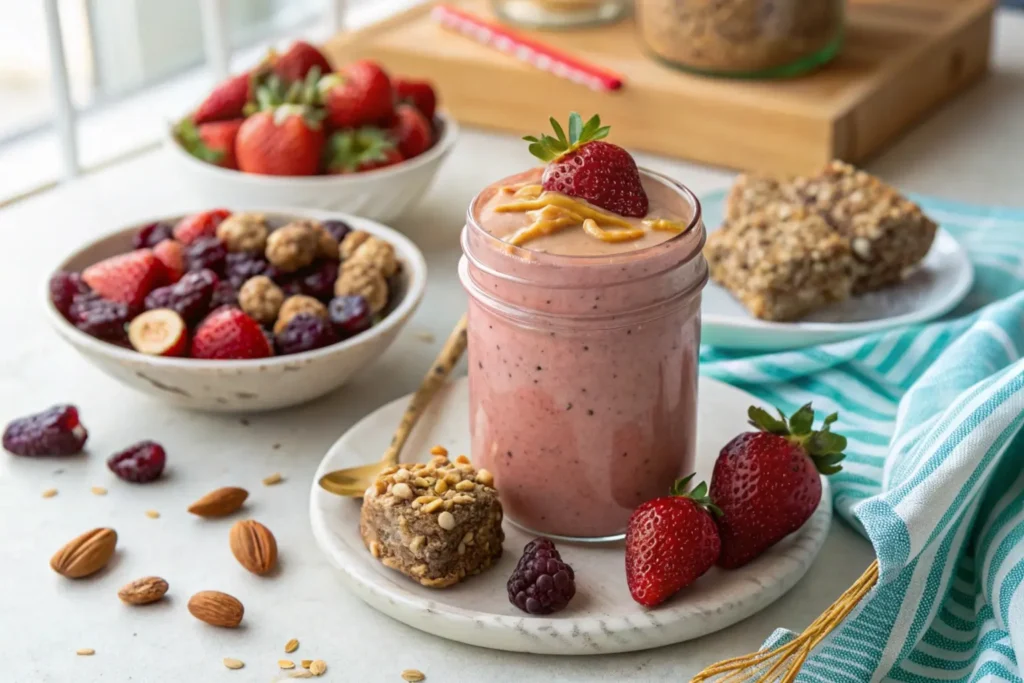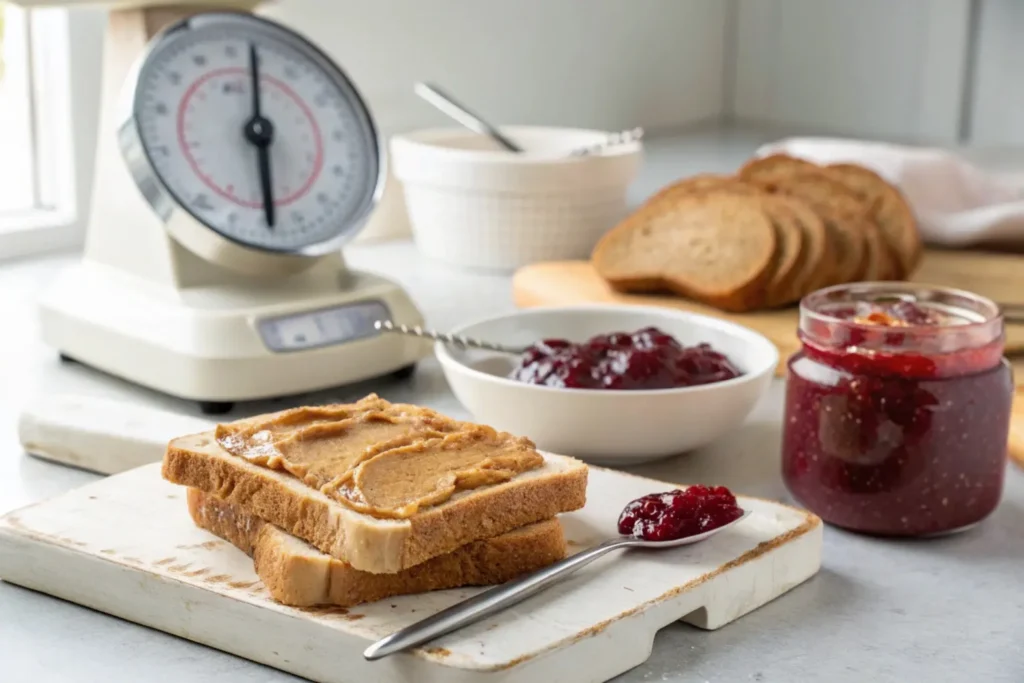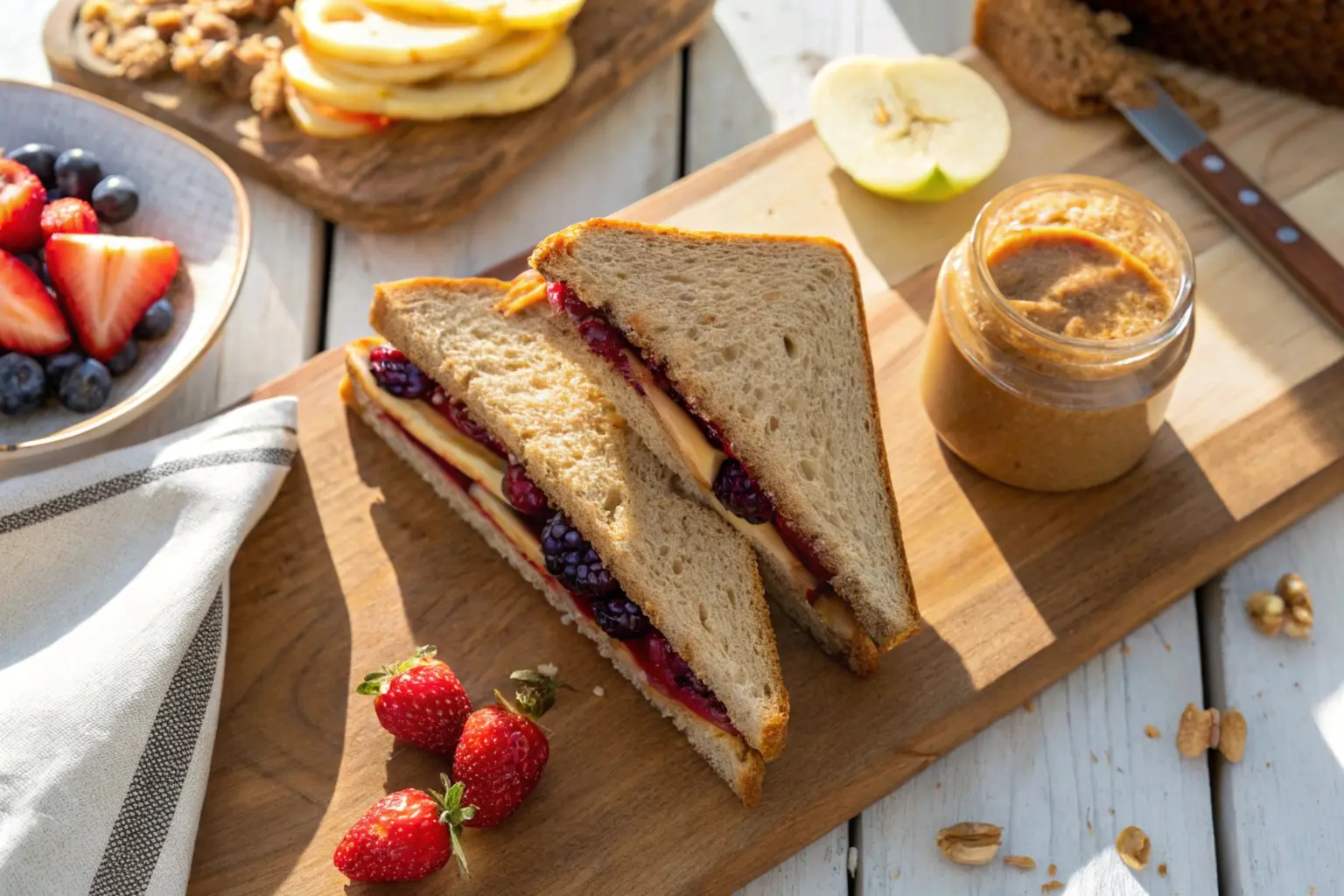Peanut butter and jelly sandwiches are a timeless classic—quick, easy, and undeniably delicious. For many, they’re a childhood staple, while others enjoy them as a convenient snack or meal on the go. But is it okay to eat peanut butter and jelly every day? This seemingly simple question has sparked debates about nutrition, health, and balance.
In this article, we’ll explore the nutritional profile of PB&J sandwiches, their pros and cons, and whether they fit into a healthy daily diet. We’ll also share tips on making your PB&J healthier and answer common questions to help you decide if this beloved combo can truly be part of your everyday routine.
Table of Contents
Nutritional Profile of Peanut Butter and Jelly
What’s in Peanut Butter and Jelly?
At its core, a peanut butter and jelly sandwich consists of three main components: bread, peanut butter, and jelly. While these ingredients may seem simple, their nutritional content can vary significantly based on your choices.
- Bread: White bread, the traditional choice, is soft and mild but often lacks fiber and nutrients. Whole wheat or multigrain bread, however, provides more fiber, vitamins, and minerals, making it a healthier base for your sandwich.
- Peanut Butter: Peanut butter is a nutrient-dense spread packed with protein, healthy fats, and essential vitamins like vitamin E. However, some brands contain added sugars, oils, and salt, which can reduce their nutritional value.
- Jelly: Jelly or jam adds sweetness and flavor but is often high in sugar and low in nutrients. Choosing low-sugar or fruit-only spreads can make your PB&J healthier.
Nutritional Benefits of PB&J Ingredients
Despite its reputation as a simple snack, a PB&J sandwich can provide a balanced combination of macronutrients:
- Protein: Peanut butter is an excellent source of protein, which helps with muscle repair and keeps you feeling full longer.
- Healthy Fats: The natural fats in peanut butter are primarily unsaturated, which support heart health and provide sustained energy.
- Fiber: When paired with whole grain bread, PB&J sandwiches can be a good source of fiber, aiding digestion and promoting gut health.
The Pros of Eating PB&J Daily
Protein, Healthy Fats, and Fiber in PB&J
One of the biggest advantages of eating peanut butter and jelly sandwiches is their nutritional balance. When you ask, Is it okay to eat peanut butter and jelly every day?, the answer often depends on how well the sandwich supports your health goals.
Peanut butter is rich in protein, which helps repair muscles and keeps you feeling full longer. For those with busy lifestyles, the combination of protein and healthy fats in peanut butter provides sustained energy throughout the day. Meanwhile, whole grain bread adds fiber to the meal, supporting digestion and promoting a healthy gut.
The fiber and healthy fats in this sandwich work together to slow digestion, which prevents blood sugar spikes. This makes PB&J a better option than many sugary snacks or processed convenience foods. So, if you’re looking for a meal that’s both quick and nourishing, a thoughtfully prepared PB&J can be a great choice.
How PB&J Can Support Active Lifestyles
PB&J isn’t just a childhood favorite—it’s also a go-to snack for athletes and fitness enthusiasts. The carbs from the bread and jelly provide a quick source of energy, making it an ideal pre- or post-workout meal.
Additionally, peanut butter contains potassium and magnesium, two important minerals that help with muscle function and recovery. Whether you’re heading out for a long run or powering through a workout at the gym, a PB&J sandwich offers a simple way to refuel.
When paired with a piece of fruit or a handful of nuts, this sandwich becomes even more nutritious, giving you the energy and nutrients you need to stay active.
Potential Downsides of Eating PB&J Every Day
Excess Calories and Risk of Weight Gain
While PB&J sandwiches offer many benefits, eating them every day can have downsides, especially if you’re not mindful of portion sizes. Is it okay to eat peanut butter and jelly every day? Well, it depends on how many calories you’re consuming.
Peanut butter is calorie-dense, with just two tablespoons containing around 190 calories. If you’re generous with your spreads or use high-sugar jelly, the calorie count of your sandwich can add up quickly. Over time, consistently eating more calories than you burn could lead to unwanted weight gain.
To avoid this, consider measuring your portions and opting for lighter bread options, such as whole wheat or multigrain. Using natural peanut butter and low-sugar jelly can also reduce unnecessary calories.
Impact of Sugary Jelly and Processed Bread
Another concern with eating PB&J daily is the potential impact of sugary and processed ingredients. Many popular jelly brands are loaded with added sugar, which can contribute to energy crashes and increase the risk of health issues like diabetes or tooth decay.
Similarly, white bread, though soft and nostalgic, lacks the fiber and nutrients found in whole grain or multigrain options. Processed bread can lead to blood sugar spikes, which may leave you feeling hungry shortly after eating.
For a healthier alternative, switch to whole grain bread, which provides more nutrients and a slower release of energy. When choosing jelly, look for options labeled as “fruit-only” or “low-sugar” to minimize your sugar intake while still enjoying the sweetness.
No specific internal links related to “Is it okay to eat peanut butter and jelly every day?” were found in the sitemap. Therefore, I’ll add a small suggestion encouraging readers to explore other relevant recipes on the website.
Healthier Ways to Enjoy PB&J Daily
Choosing Whole Grain or Multigrain Bread
One of the easiest ways to make a peanut butter and jelly sandwich healthier is by upgrading your bread. Instead of using white bread, opt for whole grain or multigrain options. These breads are richer in fiber, vitamins, and minerals, which not only keep you fuller for longer but also support better digestion.
Is it okay to eat peanut butter and jelly every day when made with whole grain bread? Absolutely! Whole grains provide slow-releasing carbohydrates, helping to maintain steady energy levels throughout the day. Furthermore, multigrain bread often includes seeds like flax or sunflower, adding a delightful crunch and even more nutrients to your PB&J.
Opting for Natural Peanut Butter and Low-Sugar Jams
Not all peanut butter and jelly spreads are created equal. Traditional peanut butter can contain added sugars, oils, and salts that reduce its nutritional benefits. Instead, choose natural peanut butter made with 100% peanuts. This simple swap eliminates unnecessary additives and enhances the nutritional value of your sandwich.
Similarly, consider swapping sugary jellies with fruit-only or low-sugar spreads. These alternatives preserve the sweetness without the extra calories, making it easier to enjoy PB&J daily without feeling guilty.
Portion Control and Balanced Pairings
While a PB&J sandwich can be a healthy choice, portion control is key. Stick to two tablespoons of peanut butter and one tablespoon of jelly per sandwich to avoid excessive calorie intake. Pairing your PB&J with fresh fruits like apple slices or a handful of berries can add vitamins and fiber to round out the meal.
Alternatives to the Classic PB&J
PB&J Smoothies and Energy Bites

If you’re wondering Is it okay to eat peanut butter and jelly every day? but you want some variety, smoothies and energy bites are fantastic options to switch things up while keeping the same great flavors.
For a PB&J smoothie, blend peanut butter, fresh or frozen berries, a banana, and your choice of milk (like almond or oat milk). To add more protein, toss in a scoop of protein powder or Greek yogurt. The result is a creamy, nutrient-packed drink that’s refreshing and satisfying, whether as a breakfast or an afternoon pick-me-up.
Energy bites are another creative alternative. Combine oats, peanut butter, honey, and chopped dried fruit like raisins or cranberries. Roll them into bite-sized balls and refrigerate for a quick, no-bake snack. These portable bites are perfect for busy days, and they pack the same delicious PB&J flavor into a convenient, on-the-go format.
PB&J with Different Nut Butters or Fresh Fruit
Another great way to diversify your PB&J experience is by experimenting with different nut butters or adding fresh fruit to your sandwich. Almond butter is a popular alternative, offering a slightly sweet and nutty flavor. Cashew butter, on the other hand, is creamier and pairs wonderfully with tart jellies like blackberry or apricot.
For an even fresher take, swap out traditional jelly for fruit slices. Strawberries, blueberries, or banana slices can bring a natural sweetness and a juicy texture to your PB&J. Plus, using whole fruits reduces added sugar while boosting the nutritional value of your sandwich.
Toasted PB&J and Creative Add-Ons
Toasting your PB&J sandwich is a small change that can make a big difference. The toasted bread adds a delightful crunch, while the warmth enhances the flavors of the peanut butter and jelly. For extra creativity, try adding toppings like a drizzle of honey, chia seeds, or even a sprinkle of cinnamon.
Another fun twist is layering in other ingredients for texture and flavor. Add granola for a satisfying crunch, or spread cream cheese as a base layer before adding peanut butter and jelly for a richer taste. With so many possibilities, it’s easy to enjoy PB&J every day in new and exciting ways.
Whether you’re sipping on a PB&J smoothie, enjoying energy bites, or trying a toasted sandwich with unique toppings, these alternatives ensure that your love for PB&J remains fresh and exciting!
FAQs About Eating PB&J Daily
Can PB&J Be a Healthy Breakfast Option?
Absolutely! Is it okay to eat peanut butter and jelly every day as part of your breakfast? Yes, when prepared thoughtfully. A PB&J sandwich made with whole grain bread, natural peanut butter, and low-sugar jelly can be a nutritious way to start the day. The healthy fats and protein from the peanut butter, combined with the fiber-rich bread, provide sustained energy, making it an excellent choice for busy mornings.
For added nutrients, pair your sandwich with a side of fresh fruit or a smoothie. This helps balance the meal while adding essential vitamins and minerals to your breakfast.
Is PB&J Good for Weight Loss?

PB&J can fit into a weight-loss plan, but portion control is crucial. Peanut butter is calorie-dense, so sticking to a moderate amount—around two tablespoons—helps avoid overloading on calories. Pairing your PB&J with whole grain bread and fruit-only jelly also reduces sugar and increases fiber, making it a more weight-loss-friendly option.
If you’re concerned about the calorie count, consider making an open-faced sandwich using just one slice of bread. This simple tweak cuts down on carbs while keeping the same great flavor.
How Often Should You Eat PB&J?
The answer to Is it okay to eat peanut butter and jelly every day? ultimately depends on your overall diet and health goals. If your PB&J is made with healthy ingredients and balanced with other nutrient-rich foods throughout the day, enjoying it daily can be perfectly fine. However, variety is key to meeting all your nutritional needs.
Try rotating PB&J with other meals like salads, wraps, or soups to keep your diet interesting and well-rounded. By doing so, you’ll continue to enjoy the benefits of PB&J while maintaining a diverse and nutritious eating plan.

